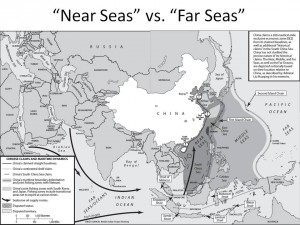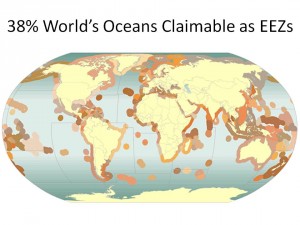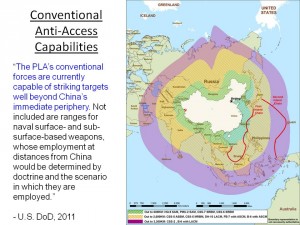China SignPost™ (洞察中国) #55–Near Seas “Anti-Navy” Capabilities, not Nascent Blue Water Fleet, Constitute China’s Core Challenge to U.S. and Regional Militaries
Andrew S. Erickson and Gabriel B. Collins, “Near Seas ‘Anti-Navy’ Capabilities, not Nascent Blue Water Fleet, Constitute China’s Core Challenge to U.S. and Regional Militaries,” China SignPost™ (洞察中国) 55 (6 March 2012).
China SignPost™ 洞察中国–“Clear, high-impact China analysis.”©
Strategic Horizon 1A: The U.S.-China relationship is central to international relations in the twenty-first century, as the two great Asia-Pacific powers compete, coexist, and cooperate across the full spectrum of national capabilities. While they share many important interests and are increasingly interdependent, particularly in the economic realm, Beijing and Washington regrettably face substantial differences regarding important security issues. This friction can likely be managed, albeit at the cost of tremendous effort and patience on both sides, but occasional crises are likely (akin to the 2001 EP-3 incident), and conflict cannot be ruled out completely if wisdom and diligence prove insufficient. The best way to avoid conflict is to understand its potential nature and cost. To that end, this four-part series will examine four major, under-researched issues:
- China’s Near Seas military focus and capabilities
- China’s fiscal environment and implications for military development
- Chinese energy and resource imports and their potential to drive naval expansion
- China’s conflict triggers and mitigating factors, particularly economic interdependence
While this series will retain China SignPost™ (洞察中国)’s traditional Sino-centric focus, it must be noted that the U.S. and its capabilities, policies, and actions represent a major part of the strategic equation. Beijing’s views and concerns about them will shape Chinese actions that will, in turn, influence U.S. policy decisions.
The Near Seas: Sino-American Strategic and Military Dynamics
For all their potential progress elsewhere, for the foreseeable future, the U.S. and China are unlikely to reach a mutually acceptable understanding over the status of, and norms within, the Near Seas (Yellow, East, and South China seas). This maritime area contains the vast majority of China’s outstanding territorial claims, as well as all its disputed maritime claims. The Sinocentric concept of Near Seas (近海)—like Middle (中海) and Far Seas (远海), as depicted in the map above—was defined by Admiral Liu Huaqing, who modernized China’s Navy as its Commander from 1982-88.[i]
Contested islands claimed by China include Taiwan (first and foremost), the Senkakus/Diaoyus in the East China Sea, and the Spratlys and Paracels and other islands and reefs in the South China Sea. China cites the 1982 UN Convention on the Law of the Sea (UNCLOS) and typically claims a 200 nautical mile exclusive economic zone (EEZ) around these islands. UNCLOS has been ratified by 161 states and the European Union but not by the U.S., which is only a signatory—greatly limiting its ability to lead and influence in the critical international maritime law arena.
China’s claims are often contested or overlap with those of its neighbors, and it promotes revisionist and inconsistent interpretations of what activities are legally permissible in the EEZ. For instance, China leads a 23 state group of the 192 UN member states who seek a minority interpretation of UNCLOS that would restrict foreign military access within China’s claimed EEZ and the airspace above it.[ii] If this approach were adopted, China could prohibit foreign military operations in major swaths of South China Sea, thereby threatening freedom of navigation in some of the world’s most important shipping and energy lanes. Accepting the minority view on EEZ access would also set a precedent for the 38% of the world’s ocean area potentially claimed as EEZ to be similarly restricted—even by states such as Somalia that utterly lacks the capacity to maintain order in the face of sub-state threats.
Beijing opposes foreign military involvement in the Near Seas, fearing that it could affect the disposition of Chinese maritime claims, and limit China’s growing influence as a regional power. As part of this policy, China objects to U.S. surveillance and reconnaissance (SRO) activities in international waters and airspace within and over its claimed EEZ. To assert its displeasure and to apply political pressure, China regularly intercepts aerial SRO missions.
China also increasingly uses civil maritime enforcement vessels and government-controlled fishing vessels to pressure U.S. ships engaged in SRO. Chinese tactics have been quite aggressive, as with the harassment of the survey vessel USNS Impeccable in March 2009 in international waters 75 miles south of Hainan Island.[iii] Meanwhile, China is developing, deploying, and displaying military platforms and weapons systems potentially capable of threatening, rendering inoperable, or even destroying U.S., allied, and friendly platforms that attempted to intervene in the unfortunate event of conflict. These capabilities are termed “counter-intervention” by Chinese sources and “anti-access/area denial” (A2/AD) by the U.S. military. While some substantive nuances are alleged to exist between these concepts, the difference is fundamentally one of perspective as they are two sides of the same coin.[iv] Chu Shulong, a professor of international relations at Tsinghua University’s School of Public Policy and Management, encapsulates Beijing’s motives in this regard: “China is aiming to deny the capability of possible American intervention in the western Pacific. That has been clear since 1996.”[v]
This Chinese determination to establish a maritime buffer zone chafes increasingly against U.S. efforts to defend open access to the global commons, public zones in the seas, air, space, and cyberspace that are used by all nations but owned by none. Of particular concern for Washington, and many of China’s neighbors, is freedom of navigation in the South China Sea, which carries a substantial portion of global commerce and seaborne energy flows.
Henry Kissinger captures the respective concerns prevalent in each nation:
Some American strategic thinkers argue that Chinese policy pursues two long-term objectives: displacing the United States as the preeminent power in the western Pacific and consolidating Asia into an exclusionary bloc deferring to Chinese economic and foreign policy interests. … China’s neighbors, dependent as they are on Chinese trade and uncertain of the United States’ ability to react, might adjust their policies according to Chinese preferences. Eventually, this could lead to the creation of a Sinocentric Asian bloc dominating the western Pacific. …
On the Chinese side, the confrontational interpretations follow an inverse logic. They see the United States as a wounded superpower determined to thwart the rise of any challenger, of which China is the most credible. No matter how intensely China pursues cooperation, some Chinese argue, Washington’s fixed objective will be to hem in a growing China by military deployment and treaty commitments, thus preventing it from playing its historic role as the Middle Kingdom. In this perspective, any sustained cooperation with the United States is self-defeating, since it will only serve the overriding U.S. objective of neutralizing China. Systematic hostility is occasionally considered to inhere even in American cultural and technological influences, which are sometimes cast as a form of deliberate pressure designed to corrode China’s domestic consensus and traditional values.[vi]
“Anti-Navy,” Not “Blue Water Navy,” Constitutes Primary Challenge to U.S. Forces
Concerns about a Chinese “blue water navy” fundamentally mischaracterize the true nature of China’s present and medium-term challenge to the U.S. Navy and other U.S. and allied forces.[vii] Because of the fundamentally different cost dynamics, and China’s very different levels of military capability in the Near and Far Seas, it is important for analysts not to conflate Near Seas high-intensity A2/AD with Far Seas low-intensity presence, and even influence.[viii]
Beijing’s “blue water” naval expansion remains years from posing a serious problem for Washington. Indeed, as a growing great power, it is only natural for China to play an increasing role in this realm, and in many respects it should be welcomed. The U.S. has and will continue to have many viable options to address any problems that might emerge in this area, at least with respect to the potential for high-intensity kinetic conflict.
For instance, Chinese forces themselves are highly vulnerable to precisely the same types of “asymmetric” approaches (e.g., missile attacks) that they can employ to great effect closer to China’s shores. In fact, there is substantial room for cooperation beyond the Near Seas. This potential may even be said to be growing, as China’s overseas interests and capabilities increase, thereby allowing it to contribute in unprecedented ways. In this area, which covers the vast majority of the globe, China appears to be cautiously open to U.S. ideas about “defense of the global system”—which in fact offer excellent opportunities for “free riding” off U.S.-led provision of security for key global sea lanes such as the Strait of Hormuz.
The problem for the U.S. is that in the Near Seas themselves China is working to carve out a sphere of strategic influence within which freedom of navigation and other important international system-sustaining norms are seriously constricted. Thus, China’s already-present ability to engage in A2/AD operations within the Near Seas and their immediate approaches has the potential to seriously undermine U.S. national security interests.
Assisted in part by the land-based Second Artillery Force, anti-satellite capabilities, and global cyber activities, this A2/AD challenge threatens U.S. naval platforms, but is far more than just a Chinese navy-based threat; some U.S. government experts have called it an “anti-navy.” It could already be difficult to handle kinetically with current U.S. approaches, and the situation appears to be worsening rapidly. The U.S. may not have years to develop new countermeasures and prepare to address the most difficult aspects of the problem; in that sense, “the future is now.”[ix]
Radiating Range Rings, Through the Lens of Distance
The most common source of error in Chinese and U.S. analyses of People’s Liberation Army (PLA) development is the conflation of two factors: scope and intensity. A stone dropped into the water forms waves that radiate outward, gradually dissipating in the process. Close to home, China’s military capabilities are rapidly reaching a very high level. However, they are making much slower progress, from a much lower baseline, further away. The major exceptions to this pattern occur in space, in which China’s capabilities are more evenly distributed and hence more global in nature, and in cyberspace in which physical distances are largely meaningless.
To call this a “tale of two militaries” oversimplifies, since some platforms and weapon systems can contribute in both areas, but it captures the basic dynamic. Many vehicles and armaments are primarily relevant in one area or the other. Cherry-picking the characteristics of either of these “layers” or “levels” to characterize overall Chinese military/maritime power risks fundamentally misrepresenting its critical dynamics.
On one hand, it is a mistake to exaggerate the scope of China’s military buildup: China is not developing a “blue water” power-projection navy nearly as rapidly as it is deploying shorter-range platforms and weapon systems such as missiles for land, air-, sea-, and undersea-based platforms. On the other hand, it is equally misguided to suggest that restraint and limitations in the Far Seas indicate restraint and limitations in the Near Seas, when in fact Chinese actions across the military and diplomatic spectrum strongly suggest the opposite.
“Counting all the beans” by treating side-by-side comparison of all Chinese and U.S. forces as the key metric, as sometimes done by those who would minimize the PLA’s significance, is only relevant if one assumes that the pertinent scenario is a Cold War-style Sino-American global conflict—a virtual impossibility, fortunately. Rather, China is seeking to further its core interests by pursuing an asymmetric approach that maximizes its advantages in a contingency relatively close to China’s maritime periphery.
Bottom Line: “Anti-Navy” Friction and Navy Cooperation
For the foreseeable future, Washington and Beijing are unlikely to agree on the status of the Near Seas, and what activities are acceptable within this zone. Given its essential interests in the area, Beijing is developing “keep out”[x] capabilities to thwart American intervention. Meanwhile, Washington’s commitment to maintaining the existing global system of free access to the global aerial and maritime commons leads it to oppose China’s aims.
Therefore, the key immediate and medium-term challenge to the U.S. Navy and military more broadly is not nascent Chinese “blue water naval development”—which in fact could support substantial cooperation—but rather China’s rapidly growing asymmetric multi-service A2/AD capabilities within the Near Seas and their immediate approaches. U.S. forces may not be fully prepared to contend with this Dragon’s Lair[xi] of layered anti-access systems and the issue drives considerable debate in Washington.[xii]
In this time of geostrategic ferment, Henry Kissinger offers a possible way forward:
Just as Chinese influence in surrounding countries may spur fears of dominance, so efforts to pursue traditional American national interests can be perceived as a form of military encirclement. Both sides must understand the nuances by which apparently traditional and apparently reasonable courses can evoke the deepest worries of the other. They should seek together to define the sphere in which their peaceful competition is circumscribed. If that is managed wisely, both military confrontation and domination can be avoided; if not, escalating tension is inevitable. It is the task of diplomacy to discover this space, to expand it if possible, and to prevent the relationship from being overwhelmed by tactical and domestic imperatives.[xiii]
About Us
China Signpost™ 洞察中国–“Clear, high-impact China analysis.”©
China SignPost™ aims to provide high-quality China analysis and policy recommendations in a concise, accessible form for people whose lives are being affected profoundly by China’s political, economic, and security development. We believe that by presenting practical, apolitical China insights we can help citizens around the world form holistic views that are based on facts, rather than political rhetoric driven by vested interests. We aim to foster better understanding of key internal developments in China, its use of natural resources, its trade policies, and its military and security issues.
China SignPost™ 洞察中国 founders Dr. Andrew Erickson and Mr. Gabe Collins have more than a decade of combined government, academic, and private sector experience in Mandarin Chinese language-based research and analysis of China. Dr. Erickson is an Associate Professor at the U.S. Naval War College’s China Maritime Studies Institute (CMSI) and an Associate in Research at Harvard’s John King Fairbank Center for Chinese Studies. Mr. Collins is a law student at the University of Michigan Law School. His research focuses on commodity, security, and rule of law issues in China, Russia, and Latin America.
The positions expressed here are the authors’ personal views. They do not represent the U.S. Naval War College, Navy, Department of Defense, or Government, and do not necessarily reflect the policies or estimates of these or any other organizations.
The authors have published widely on maritime, energy, and security issues relevant to China. An archive of their work is available at www.chinasignpost.com.
[i] 刘华清 [Liu Huaqing], 刘华清回忆录 [The Memoirs of Liu Huaqing] (Beijing: People’s Liberation Army, 2004); Nan Li, “The Evolution of China’s Naval Strategy and Capabilities: From ‘Near Coast’ and ‘Near Seas’ to ‘Far Seas,’” Asian Security, 5.2 (June 2009): 144-69.
[ii] Peter A. Dutton, “China’s Efforts to Assert Legal Control of Maritime Airspace,” in Andrew Erickson and Lyle Goldstein, eds., Chinese Aerospace Power: Evolving Maritime Roles (Annapolis, MD: Naval Institute Press, 2011), 90-107, http://www.andrewerickson.com/2011/06/chinese-aerospace-power-evolving-maritime-roles-cmsi-vol-5/.
[iii] “USNS Impeccable Harassed by Chinese Vessels,” video footage of Impeccable Incident, uploaded on 25 March 2009. http://www.youtube.com/watch?v=hQvQjwAE4w4.
[iv] Anton Lee Wishik II, “An Anti-Access Approximation: The PLA’s Active Strategic Counterattacks on Exterior Lines,” China Security 19 (2011): 37-48, http://www.chinasecurity.us/index.php?option=com_content&view=article&id=487; Thomas G. Mahnken, “China’s Anti-Access Strategy in Historical and Theoretical Perspective,” Journal of Strategic Studies, 34.3 (June 2011): 299-323, http://www.tandfonline.com/toc/fjss20/34/3.
[v] “Continuing Buildup, China Boosts Military Spending More Than 11 Percent,” New York Times, 4 March 2012, http://www.nytimes.com/2012/03/05/world/asia/china-boosts-military-spending-more-than-11-percent.html?pagewanted=2&_r=1&hp.
[vi] Henry A. Kissinger, “The Future of U.S.-Chinese Relations: Conflict Is a Choice, Not a Necessity,” Foreign Affairs (March/April 2012), http://www.foreignaffairs.com/articles/137245/henry-a-kissinger/the-future-of-us-chinese-relations.
[vii] Leo Hindery, Jr., “China: Continued Abusive Trade and Now a ‘Blue Water Navy’,” Huffpost, 10 January 2012, http://www.huffingtonpost.com/leo-hindery-jr/china-continued-abusive-t_b_1196360.html.
[viii] For misguided comparison of U.S. overall (global) capabilities with Chinese overall (regionally-focused) capabilities, see Amitai Etzioni, “In China’s Shoes (Commentary),” The National Interest, 23 January 2012, http://nationalinterest.org/commentary/chinas-shoes-6366.
[ix] For details, see Andrew S. Erickson, “Through the Lens of Distance: Understanding and Responding to China’s ‘Ripples of Capability’,” Changing Military Dynamics In East Asia Policy Brief 10, January 2012, Project on the Study of Innovation and Technology in China, University of California Institute on Global Conflict and Cooperation, http://igcc.ucsd.edu/assets/001/502847.pdf.
[x] See, for example, Paul S. Giarra, “A Chinese Anti-Ship Ballistic Missile: Implications for the U.S. Navy,” in Chinese Aerospace Power, 359-74.
[xi] Regarding potential implications for U.S. military operations, see Roger Cliff, Mark Burles, Michael S. Chase, Derek Eaton, and Kevin L. Pollpeter, Entering the Dragon’s Lair: Chinese Anti-Access Strategies and their Implications for the United States (Santa Monica, CA: RAND, 2007), http://www.rand.org/pubs/monographs/2007/RAND_MG524.pdf.
[xii] Andrew F. Krepinevich, Jr., “The Pentagon’s Wasting Assets: The Eroding Foundations of American Power,” Foreign Affairs (July/August 2009), http://www.foreignaffairs.com/articles/65150/andrew-f-krepinevich-jr/the-pentagons-wasting-assets; Thomas Donnelly, Philip Dur, and Andrew F. Krepinevich Jr., “The Future of U.S. Military Power: Debating How to Address China, Iran, and Others,” Foreign Affairs (November/December 2009), http://www.foreignaffairs.com/articles/65507/thomas-donnelly-philip-dur-and-andrew-f-krepinevich-jr/the-future-of-us-military-power;
[xiii] Kissinger, “The Future of U.S.-Chinese Relations.”









































